OnePlus Nord 2 vs Nord 2T vs 10R performance comparison – which MediaTek-powered OnePlus is best for you? | 91mobiles.com
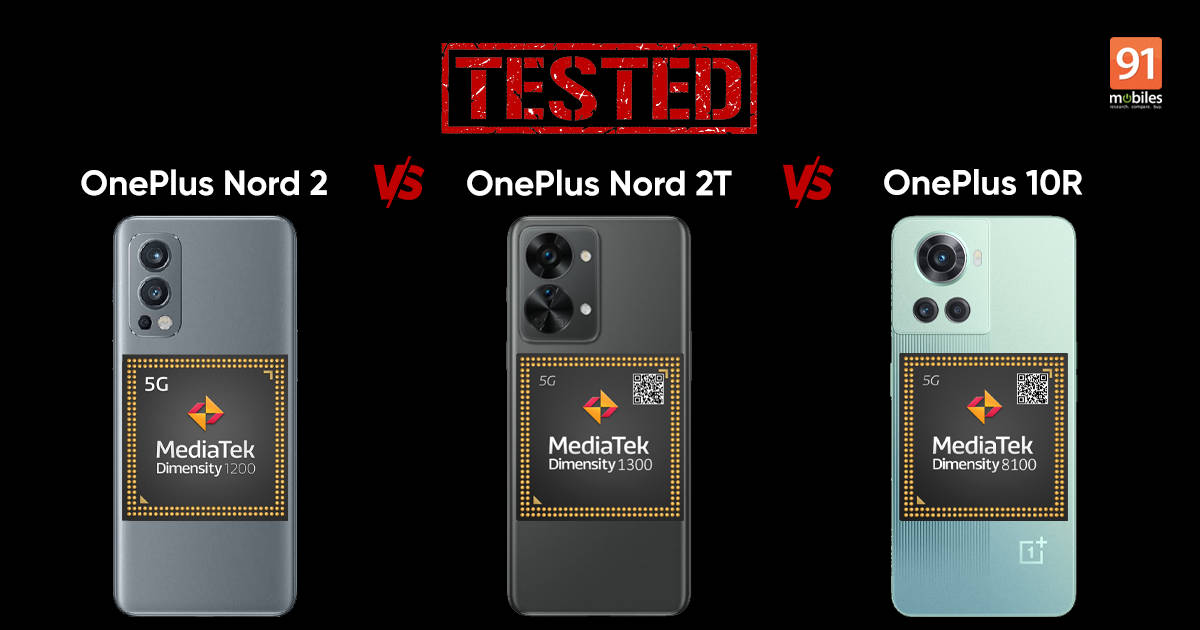
For years, a good chunk of Android phones retailing in the affordable or premium segment would fuel their smarts from a Qualcomm-branded chipset. That said, the scenery changed quickly with the advent of MediaTek’s Dimensity line of SoCs which, for the price, offered comparable performance to a Qualcomm processor. Case in point, the Dimensity 1200 platform, which could outperform most 7-series chipsets from Qualcomm’s stables at the time of its launch.

To keep the ball rolling, MediaTek recently took the wraps off the Dimensity 8100 and 1300 chipsets, which can be seen powering the OnePlus Nord 2T (review) and the OnePlus 10R (review). This begs the question – which MediaTek Dimensity-backed OnePlus phone is the best fit for you? To answer that, I put the OnePlus Nord 2 (review), the OnePlus 10R and the OnePlus Nord 2T through their paces in an in-depth performance comparison. Read on to find out which device offers the best and the worst performance.
Benchmarks
Let’s kick things off by taking a look at the results secured by our contenders in popular benchmarking applications. Now, bear in mind that for the purpose of this comparison, I had enabled the high-performance mode (which can be found in the battery settings) on all three devices. The high-performance mode makes a world of a difference when running demanding tasks. In fact, with the feature enabled, the Nord 2T’s Antutu score jumped from around 6,17,000 points to 6,92,758 points.
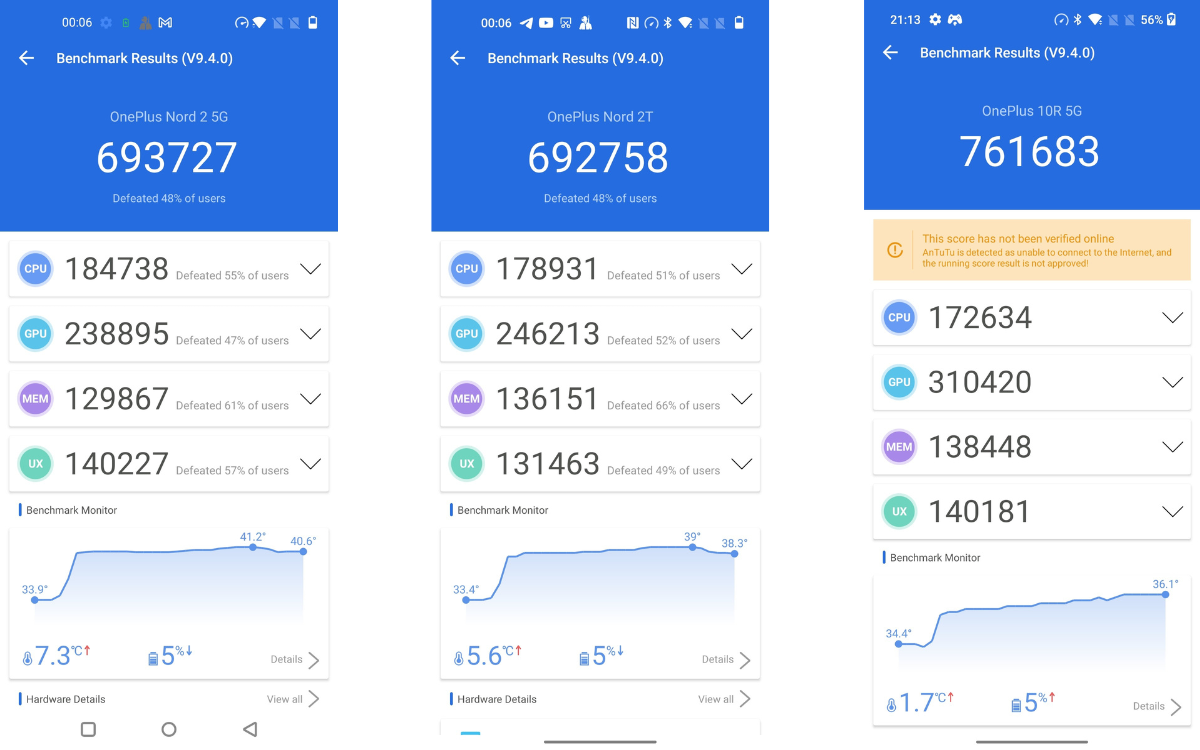
The Dimensity 8100 SoC-backed OnePlus 10R, on the other hand, yielded the highest score amounting to 7,61,683 points. To give you a better picture, the smartphone overturned a result that is on par with most devices powered by Qualcomm’s Snapdragon 888 chipset. Interestingly, the scores from the OnePlus Nord 2 and the OnePlus Nord 2T were neck and neck, with the year-old Nord 2 edging out in front ever so slightly. To wit, the device secured 6,93,727 points and therefore, was deemed the runner-up in the Antutu test run.
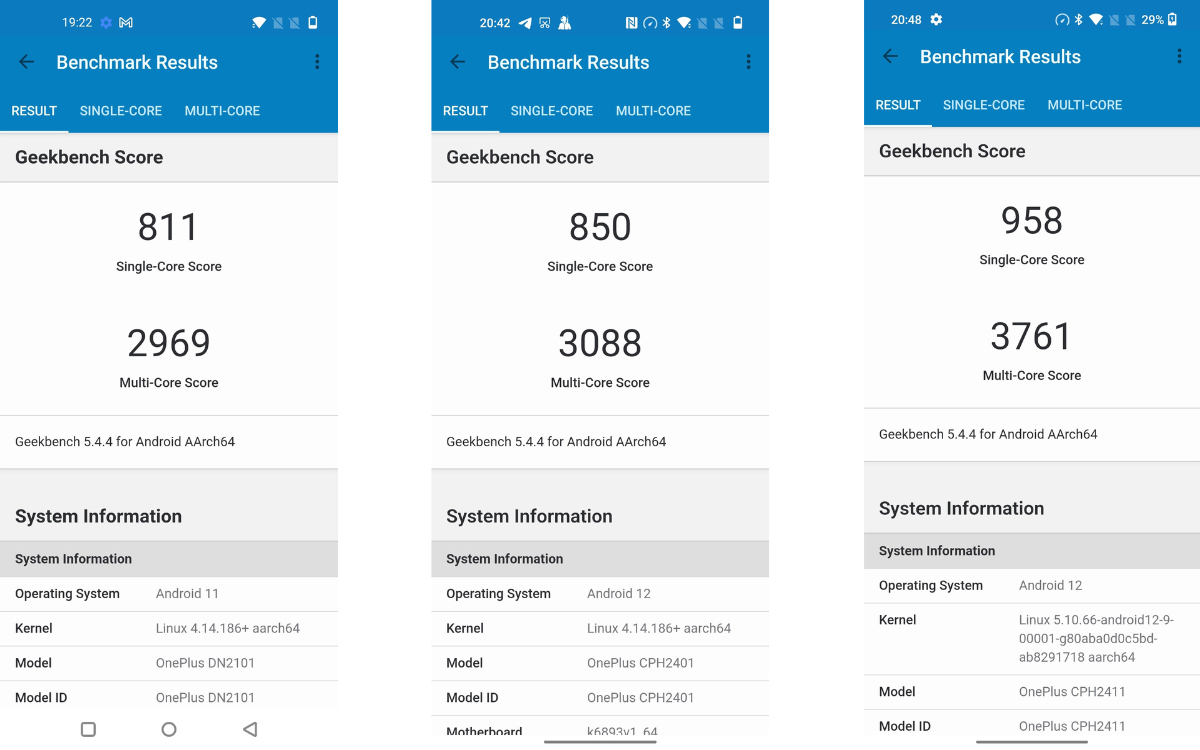
Turn the page over to GeekBench and you’ll notice a similar theme. The OnePlus 10R had the best score and the device churned out 958 and 3,761 points for the single-core and multi-core tests respectively. The Nord 2T came in second, albeit had the Nord 2 hot on its heels. To wit, the Nord 2T secured 850 and 3,088 points, whereas the Nord 2 overturned 811 and 2,969 points respectively. Understandably, the Nord 2’s scores are a couple of points shy of the Nord 2T’s results. Consequently, going by the benchmarks, it’s safe to say that the OnePlus 10R is the best-performing phone of the lot. And, while the Nord 2T had a respectable run too, the handset’s performance is eerily similar to that of the Nord 2 launched almost a year ago.
Throttling
It goes without saying that the faster the CPU, the more heat it’ll like dissipate when delivering its peak throughput. Thankfully, most new-age MediaTek chipsets keep thermal throttling at bay. Take the Dimensity 8100 SoC, for instance, which throttled to just 81 percent of its peak performance and that’s despite being subjected to 20 threads for a period of 30 minutes in the CPU throttle test. The Nord 2, on the other hand, throttled to just 78 percent. In fact, the handset outputted the highest instructions per second too.
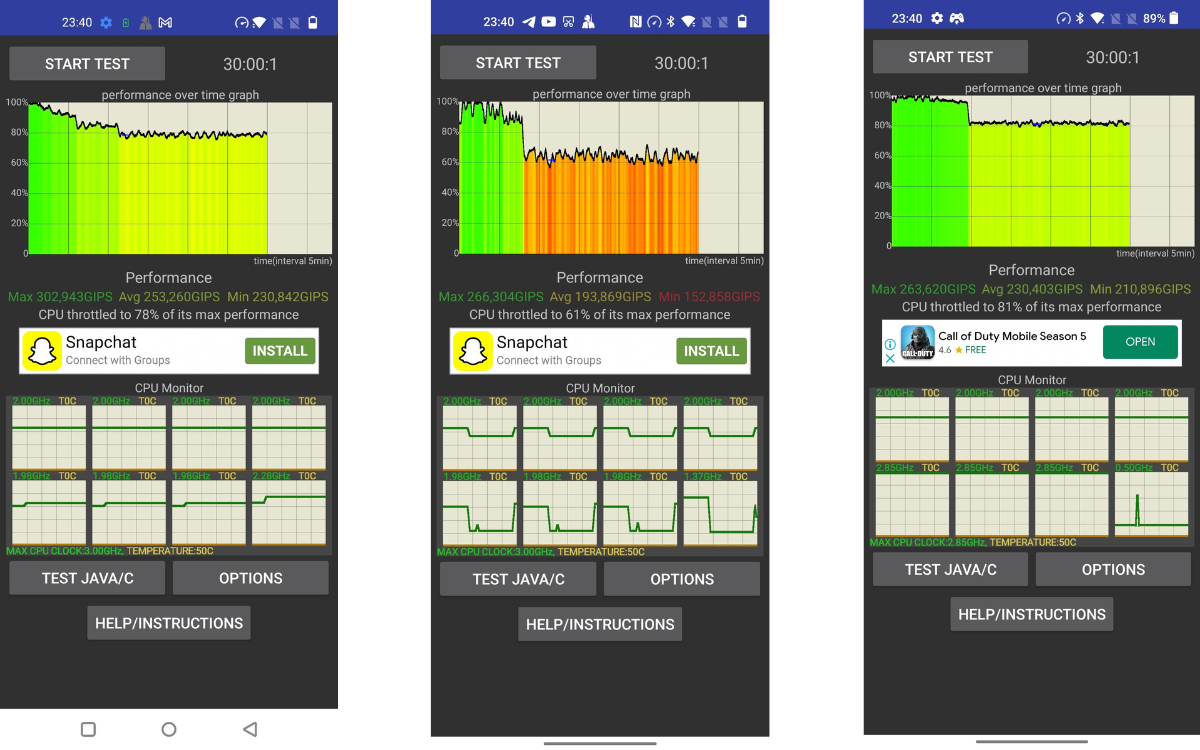
The Nord 2T, unfortunately, throttled by quite some margin and after thirty minutes, the device saw its performance dip to 61 percent of its maximum outturn. That’s quite surprising, seeing how the Dimensity 1300 SoC offers the same octa-core setup as found on the Dimensity 1200 SoC. To wit, both the chipsets feature a Cortex A78 “Ultra” core that can operate at up to 3GHz, a tri-cluster of Cortex A78 “Super” cores that are clocked at 2.6GHz and four additional Cortex A55 cores.
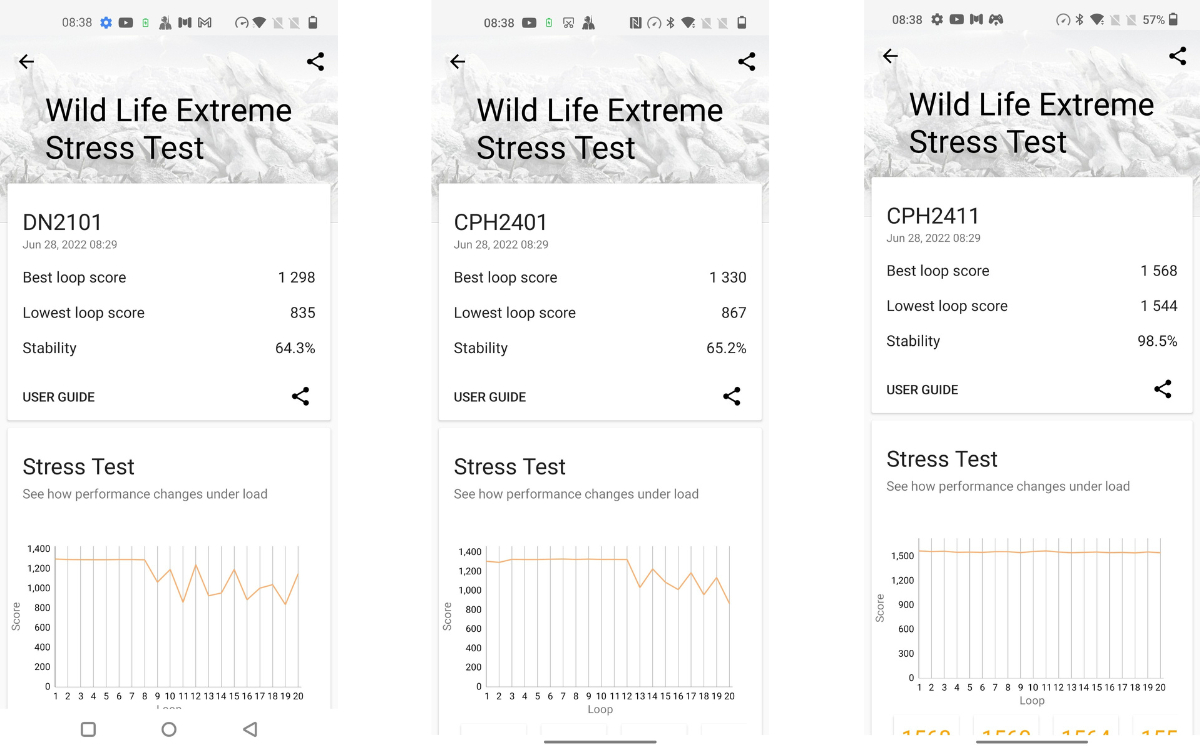
Be that as it may, I subjected the phones to 3D Mark’s Extreme stress test to further evaluate their stability under a sustained load. Now, unlike the CPU throttle test which overloads a smartphone’s SoC with multiple threads, 3D Mark’s Extreme stress test run is designed to put a GPU through its paces. In a nutshell, the benchmark mirrors a graphically-demanding game. Here, the OnePlus 10R secured the best result of the bunch and yielded 98.5 percent stability after being put through 20 loops. The OnePlus Nord 2T came in second with a 65.2 percent stability score, with the Nord 2 following closely with its 64.3 percent stability tally. From the results, it’s safe to deduce that the Nord 2T throttles quicker when exposed to CPU-intensive tasks. However, both, the Nord 2 as well as the Nord 2T should offer a similar experience when gaming over extended periods.
Gaming
Speaking of which, let’s take a closer look at how our contenders tackle popular Android games. Let’s kick things off with BGMI, which ran at the same graphics and frame rate presets on all three phones. To wit, the game can run at HDR graphics and Ultra FPS (45FPS) or Smooth graphics and Extreme FPS (60FPS) presets on the OnePlus 10R, the OnePlus Nord 2 as well as the OnePlus Nord 2T. I should add that the title can, in fact, run at 90FPS on select Dimensity 1200 and 8100-backed devices, including but not limited to the Realme X7 Max 5G (review) and the Realme GT Neo 3 (review). Consequently, you can expect the game to scale at better graphics and FPS settings on our test devices down the line too.
On the bright side, all the aforementioned chipsets can run CoD Mobile at the ‘Very High’ graphics and ‘Max’ FPS presets. What’s more, you can even enable features like anti-aliasing, god rays, etc to better the in-game graphics that much more. I should also add that my gaming experience was the same across all three handsets and I didn’t run into any instances of frame drop or stutters even after playing the frontline mode on the phones for over 40 minutes.
The scenery remains unchanged for the latest BR extravaganza, Apex Legends Mobile too. To wit, all three phones can run the game at Extreme HD graphics and Ultra FPS presets. Consequently, you will benefit from 60FPS gameplay on the trio. That said, the OnePlus 10R can even utilise the original graphics setting, which betters the visual effects tenfold albeit caps the game at 30FPS. Rest assured, the OnePlus 10R is the most adept at handling graphically-demanding games. That said, the Nord 2 and the Nord 2T can run most games at competent settings too.
Verdict
Clearly, the Dimensity 8100-backed OnePlus 10R is the best-performing OnePlus phone of the lot. It is interesting to note, however, that the OnePlus Nord 2T doesn’t offer any noticeable performance gains over the ageing OnePlus Nord 2. In fact, the Dimensity 1300 SoC is more susceptible to throttling as well.
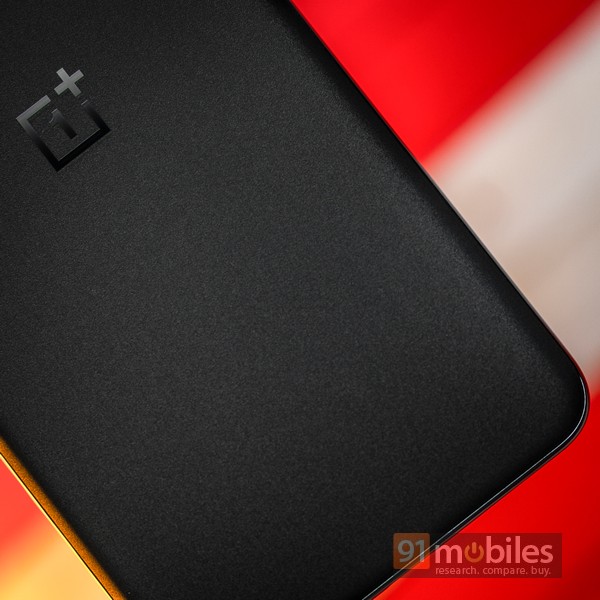
Don’t get me wrong, the chipset is still plenty fast for 2022’s standards. Furthermore, it is entirely possible that the company will finetune the SoC’s performance further via software updates. Until that comes to a pass, however, I’d reckon performance-enthusiasts should opt for the OnePlus 10R or a similarly-priced handset like the POCO F4 above the Nord 2T.
For all the latest Technology News Click Here
For the latest news and updates, follow us on Google News.
